Planning your own trip? Prepare for your trip
Use Rough Guides' trusted partners for great rates
Plan and book your private, tailor-made tour with vetted local experts
Évora is one of Portugal’s most atmospheric historic cities, where layers of Roman, Moorish, and medieval heritage sit side by side. Its Roman temple still stands proudly among whitewashed houses trimmed in ochre, while Moorish alleys twist toward a ring of medieval walls. Sixteenth-century mansions, tiled churches, and shady cloisters fill the compact center, which earned UNESCO World Heritage status for good reason.
Despite its weight of history, Évora isn’t just a museum piece. A lively university keeps the streets young, cafés buzz on summer evenings, and small restaurants serve hearty Alentejo dishes. The old town can be explored in a day, but give yourself longer if you want to soak up its atmosphere and use it as a base for the wider Alentejo region.

Hey, I’m Sara, your Portugal travel expert. Some places hit you with scenery, others with atmosphere: Évora does both. Step inside the old walls and you’ll see a Roman temple standing where it has for centuries, a cathedral whose towers let you look out across the Alentejo plains, and a chapel lined with bones that makes even seasoned travelers pause.
But Évora isn’t just a city of monuments. It’s a place where university students crowd into tiny bars, where café tables spill onto sunlit squares, and where kitchens still turn out Alentejo staples like pork with clams and rich lamb stews. The rhythm is slower here, but it never feels sleepy.
You can check off the headline sights in a day, but Évora rewards the curious. Take the time to notice azulejo tiles peeling under the sun, orange trees hidden inside convent courtyards, or pastries like pão de rala that taste of recipes whispered down through centuries. If your tour of Southern Portugal brings you to Évora, slow down; this is when the city gets under your skin.
Sara’s tip
Skip the main square for sunset and head instead to the cathedral roof. From up here, you’ll see terracotta rooftops rolling into endless plains, with barely another visitor in sight.
Best time to visit
Spring from April to June is the sweet spot, with warm days and wildflowers across the countryside. July and August often soar past 95°F (35°C), so sightseeing works best in the early morning and late evening. September and October are cooler and filled with harvest festivals, while winter is quieter and perfect for museums, hearty meals, and long evenings by the fire.
How to get to Évora
Évora is around 90 minutes by car from Lisbon, with good road links. Trains and buses also connect the two, taking about 1 hour and 45 minutes. To reach the megalithic stone circles, vineyards, or hilltop villages like Monsaraz, a car makes all the difference.
Best areas to stay in Évora
Évora sits in the heart of Portugal’s Alentejo region, about 130 km east of Lisbon. The drive takes around 90 minutes, which makes it one of the easiest inland cities to reach from the capital. Trains and buses also link Lisbon to Évora, though having a car gives you the freedom to explore vineyards, prehistoric stone circles, and fortified villages scattered across the plains.
Recognized as a UNESCO World Heritage city, Évora is often included among the best places to visit in Portugal. Its compact center, packed with Roman ruins, Gothic churches, and whitewashed houses, makes it an ideal stop on a longer Portugal itinerary. From here, you can explore Alentejo wine country, visit megalithic monuments older than Stonehenge, or wander through hilltop villages like Monsaraz.


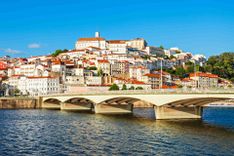
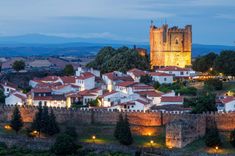

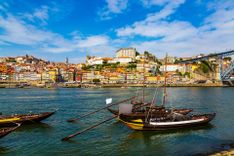










Évora’s historic center is compact and best explored on foot. The old streets are narrow, many are cobbled, and traffic inside the walls is restricted. Once you’re in the center, you won’t need a car to reach the main sights, though good shoes make a big difference.
You can see Évora’s main sights in a single full day: climb the cathedral towers, wander the Roman temple, step into the Capela dos Ossos, and linger in Praça do Giraldo over a glass of local wine. But the city is much better if you stay overnight. When the day-trippers leave, the pace slows, the streets feel more atmospheric, and dinner in a traditional tavern tastes even better without the rush.
If you’re planning a Portugal trip that includes the Alentejo, give Évora at least two days. Use the first to explore the city’s compact historic center, then dedicate the second to nearby highlights: megalithic stone circles older than Stonehenge, wineries producing robust Alentejo reds, or the hilltop village of Monsaraz overlooking the Guadiana River. An extra night also means you can enjoy the city in the evening, when the whitewashed streets glow under lamplight and the squares are filled with locals.
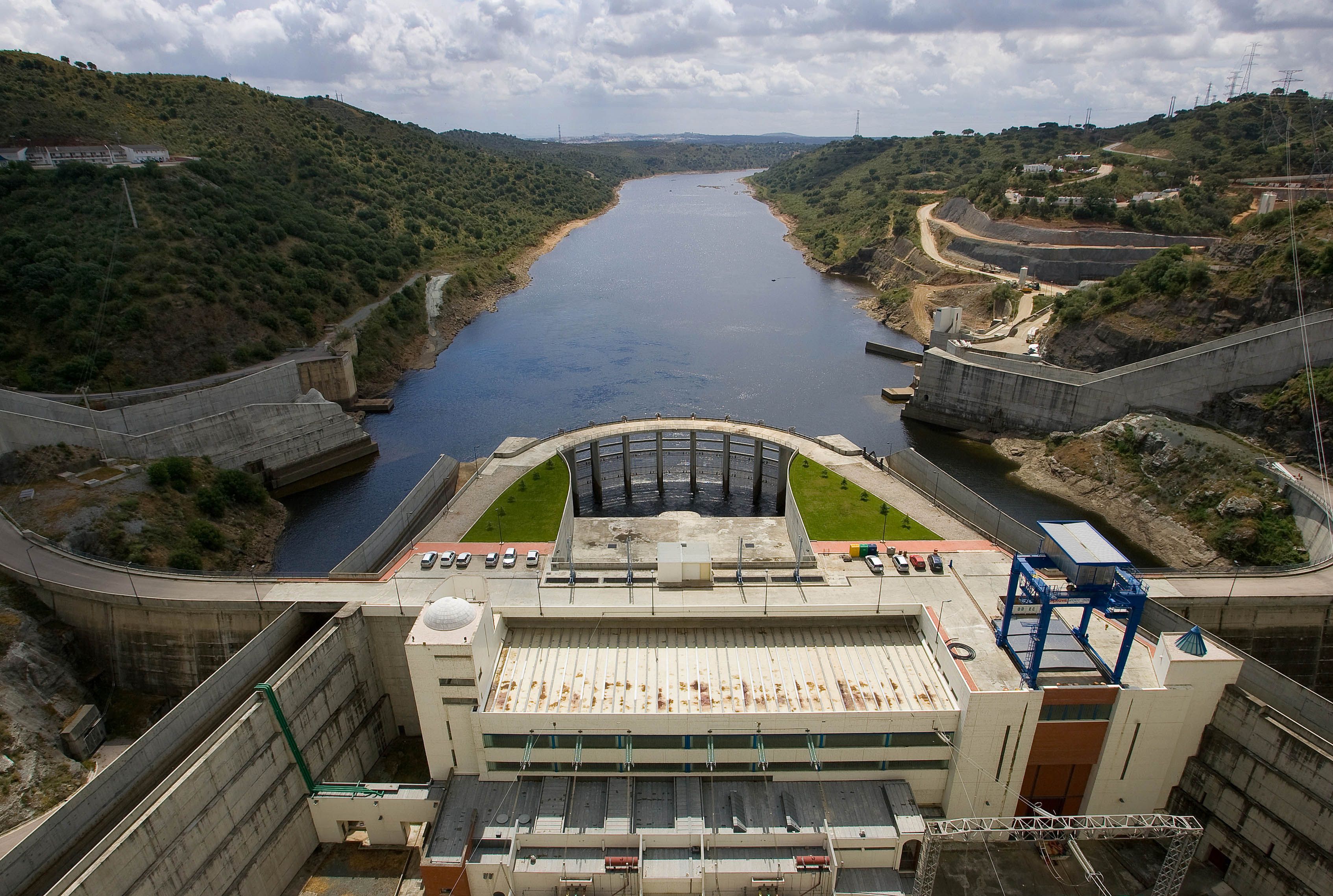
The Guadiana River, Alqueva Dam, Alentejo Province, Portugal
Évora has plenty of choice when it comes to places to stay, from boutique hotels in centuries-old mansions to rural retreats just outside the city walls. Where you base yourself depends on how you want to experience the city.

Evora old town in Portugal © Shutterstock
Évora is more than a museum-piece city. Every street has layers of Roman, Moorish, and Portuguese history, but the living culture is just as strong: cafés fill the squares, students spill out of the university, and Alentejo flavors anchor the rhythm of the day. Here’s a closer look at the best things to do in Évora, with tips on how to experience them.
You’ll spot the temple before anything else, its granite columns rising unexpectedly in the middle of the city. Built in the 1st century AD, it’s often called the Temple of Diana, though no one really knows which deity it honored. What makes it striking is the way it blends into Évora’s life today: kids play football in the square, locals walk past without glancing, while visitors pause in awe.
Take time to notice the detail: the granite shafts are capped with marble brought from nearby Estremoz. The surrounding gardens, Jardim de Diana, are a good place to sit with a coffee and watch the light shift on the stones.
The cathedral isn’t just for history buffs. Its towers and rooftop walkway give you the best sense of Évora’s place in the Alentejo: terracotta rooftops, whitewashed houses, and endless plains stretching into the horizon. The interior cloisters are lined with intricate carvings, each arch framing a different angle of sky and stone. Climbing up is steep, but when you’re standing between the spires with bells above your head and the plains at your feet, you understand why the cathedral has been a symbol of power here since the 13th century.
The Bone Chapel isn’t for the faint-hearted, but it’s unforgettable. Every wall and pillar is covered with skulls and bones, arranged by monks in the 16th century when graveyards were overflowing. The chapel’s message is blunt: “We bones that are here, for yours we wait.” It’s morbid, yes, but also strangely peaceful. Sunlight filters through small windows, casting shadows on the skulls, and you find yourself whispering, as if in a library. The adjoining museum and Church of São Francisco are also worth a visit, but it’s the chapel that lingers in your mind long after.
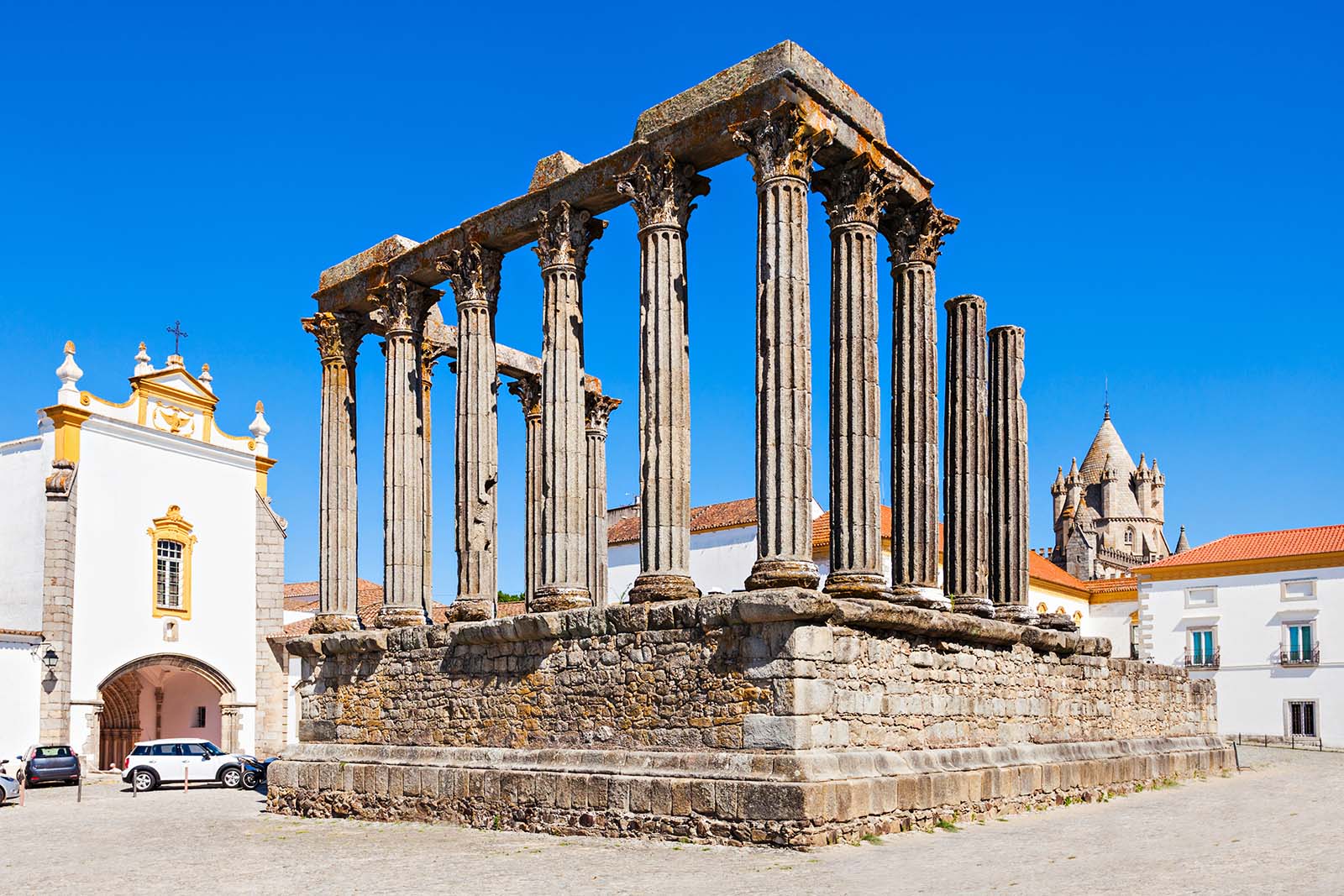
Roman Temple of Evora © Shutterstock
This square has seen executions, royal proclamations, and Inquisition trials, yet today it’s the social heart of Évora. Sit at a café under the arcades, order a galão (milky coffee), and watch the swirl of life: students rushing past, families meeting friends, and tourists eyeing the 16th-century fountain in the center. Notice the architecture, the arcaded facades reflect Moorish influence, while the church at the north end anchors the square in baroque style. At night, street musicians often play here, turning it into a stage under the stars.
Few places in Portugal capture history and scholarship like this university. Founded in the 16th century by Jesuits, it still feels steeped in centuries of learning. The cloisters are lined with blue-and-white azulejo panels showing scenes of philosophy and daily life, while the lecture halls remain as they were, wooden benches polished by centuries of students.
A guided visit helps: you’ll hear how the Jesuits educated the sons of nobility, how the school was closed in the 18th century, and how it was reborn after the Revolution. It’s quieter than other sights, so it feels like stepping into a hidden side of Évora.
The Aqueduto da Água de Prata (Aqueduct of Silver Water) is most impressive outside the city, stretching for miles across the plains, but its most charming sections are inside Évora. Houses are literally built into the arches, some with doors tucked into ancient stone. Follow Rua do Cano and its side streets, where you’ll find tiny workshops, potted plants balancing on ledges, and locals greeting each other from doorways. It’s Évora at its most everyday, history lived in, not just looked at.
A 20-minute drive takes you into one of Europe’s richest megalithic landscapes. The Cromeleque dos Almendres is older than Stonehenge, a ring of nearly 100 stones that still puzzles archaeologists. Visit at dawn or dusk, when the light is low and the place feels almost supernatural. Combine it with the Zambujeiro dolmen, a massive burial chamber, to get a sense of the prehistoric communities that once lived here. Most visitors rush through, but linger a while. The silence of the Alentejo countryside gives the stones an almost magnetic presence.
Évora is a city for eating slowly. Restaurants here serve recipes that haven’t changed much in generations. Try açorda alentejana, a simple broth of garlic, coriander, and olive oil poured over bread with a poached egg on top. Migas are another must, breadcrumbs fried with garlic and paired with pork or lamb. Wines are bold, reds especially, and they pair perfectly with hearty local dishes. Skip dessert and you’ll regret it: sericaia, a baked egg custard often topped with Elvas plums, is reason enough to linger over your meal.
Often overlooked, this museum opposite the Roman Temple is a treasure trove. It holds Roman mosaics found in local villas, medieval religious art, and even Flemish paintings that hint at Évora’s Renaissance connections. The highlight is the mosaic of a hunting scene, its animals and hunters remarkably lifelike. If the city feels like an open-air museum, this is the place that ties all its layers together.
Évora is the hub, but Monsaraz is its jewel. Perched above the Guadiana, the whitewashed village looks like it’s floating. From its castle walls, the Alqueva Reservoir stretches to the horizon, dotted with islands. In summer, the lakeshore has sandy river beaches, some of the best beaches in Portugal if you want freshwater swimming without the crowds of the coast. Stay for sunset if you can: the village glows golden, and the Alentejo sky is one of the clearest in Europe for stargazing.

Monsaraz castle and village and hot air balloons, Alentejo - Portugal © Shutterstock
Évora has a Mediterranean climate shaped by the wide plains of the Alentejo. Summers are hot and dry, winters are mild but wetter, and the long shoulder seasons bring some of the most pleasant conditions in southern Europe. Because the city sits inland, temperatures rise more sharply than on the coast, and nights can feel surprisingly cool.
Average daytime highs range from 55°F (13°C) in January to 88°F (31°C) in August, though heatwaves can push summer days above 100°F (38°C). For real-time updates, check the Portuguese Institute for Sea and Atmosphere (IPMA). Deciding on the best time to visit Portugal often depends on whether you prefer lively summer squares or quiet winter streets, and Évora delivers something special in every season.

Pousada Convento de Evora in the Historic Centre of Evora © Shutterstock
Évora’s dining scene reflects the Alentejo itself: simple, hearty, and rooted in tradition. Meals are long and unhurried, built around bread, olive oil, pork, lamb, and regional wines. Many restaurants are tucked into vaulted stone cellars or old townhouses, giving you an atmosphere to match the flavors. Expect generous servings and menus that showcase recipes passed down for generations.
Here are some unique experiences we can arrange for your tailor-made Évora trip: all private, flexible, and designed by our local travel experts.
Discover Portugal's most captivating stories
Use Rough Guides' trusted partners for great rates
written by
Olga Sitnitsa
Online editor at Rough Guides, specialising in travel content. Passionate about creating compelling stories and inspiring others to explore the world.